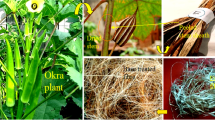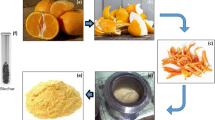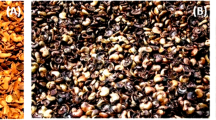Abstract
In this study, silane-treated high-content cellulose okra fiber (CCO) and macromolecule tamarind kernel powder (MTP) toughened epoxy composites are analyzed for their mechanical, thermal stability, and water-absorption behavior. The primary purpose of this research was to evaluate the impact of surface-modified high-content cellulose okra fiber and the contribution of tamarind kernel macromolecule powder on several parameters of epoxy resin composite. Surfaces of the fiber and particle were treated with 3-aminopropyltrimethoxysilane, an amino silane (APTMS). The composites were made via hand lay-up and post cured at 120 °C. It is observed that composite designation OT4 shows the highest values for tensile strength and flexural strength 162.4 MPa and 194.6 MPa respectively. Increased adherence and distribution of kernel particles in the resin, as seen in SEM images, allowed for a maximum hardness of 92 shore-D to be measured in the hardness test. In addition, the silane-treated reinforcements in composites maintained their hydrophobicity lower contact angle up to 80° and as well as 0.13 water absorption %. Thus it is clear that silane treatment process on fiber and filler particle out performed well in improving the property of composites. Such composites with improved properties would be ideal for use in the construction of buildings, military armor, sporting items, and household appliances.
Similar content being viewed by others
Data Availability
No data available to deposit as private. There is no rights.
References
Selmy et al (2019) J Thermoplast Compos Mater 32(2):267–293. https://doi.org/10.1177/0892705717751022
Najafi M, et al (2022) Springer, Singapore. https://doi.org/10.1007/978-981-15-8141-0_16-1
Abd MA, et al. (2022) J Nat Fibers 19:1, 303–318, https://doi.org/10.1080/15440478.2020.1739594
El-baky A et al (2020) J Compos Mater 54(27):4185–4205. https://doi.org/10.1177/0021998320928509
Alshahrani H, Prakash VRA (2022). Biomass Conv Bioref. https://doi.org/10.1007/s13399-022-02801-w
Prakash VRA, Rajadurai A (2016) Appl Surf Sci 384: 99–106
Rajadurai A (2017) Defence Technology 1(13):40–46
Alshahrani H, Prakash VRA (2023) Industrial Crops and Products 191: 115967
Srinivasababu N (2015) In IOP conference series: materials science and engineering, vol. 83, no. 1, p. 012003. IOP Publishing
Santulli C, Sarasini F, Fortunati E, Puglia D, Kenny JM (2014) Okra fibres as potential reinforcement in biocomposites. In Biomass and bioenergy, pp. 175–190. Springer, Cham
Gupta PK, et al. (2021) Journal of Natural Fibers 18(11): 1788–1800
Srinivasan T et al. IOP Conference Series: Materials Science and Engineering (Vol. 988, No. 1, p. 012022). IOP Publishing
Kiruthika AV, Priyadarzini TR, Veluraja K (2012) Fibers and Polymers 13(1):51–56
Chandrasekar et al. (2018) Carbohydrate Polymers. 186. https://doi.org/10.1016/j.carbpol.2018.01.057
Alshahrani H et al. (2022) J Industr Textiles 52: 15280837221137382
Ravindran et al (2020) Int J Biol Macromol 156:997–1006. https://doi.org/10.1016/j.ijbiomac.2020.04.117
Alshahrani H, Prakash VRA (2022) Progress in organic coatings 172: 107080
Abd et al (2017) Fibers Polym 18:2417–2432. https://doi.org/10.1007/s12221-017-7682-x
M. A.Abd et al. (2022) J Nat Fibers 19:3, 954–968, https://doi.org/10.1080/15440478.2020.1775750
Alshahrani H (2022) and Arun Prakash VR. Biomass Conv Bioref. https://doi.org/10.1007/s13399-022-02691-y
Marwa et al. J Nat Fibers, 18:8, 1163–1180, https://doi.org/10.1080/15440478.2019.1687069
Alshahrani H et al. (2022) Coatings 12, no. 10: 1423
Jayabalakrishnan D, et al. J. D., P. P., M. I. S.,M. V., R. S., A. P. V. R. (2021) Polym. Compos. 1.https://doi.org/10.1002/pc.2639310
Arun Prakash VR et al (2020). Biomass Conv Bioref. https://doi.org/10.1007/s13399-020-00938-0
Prakash VRA, Depoures MV (2020) Silicon 12(11): 2533–2544
Dinesh T et al (2019) Silicon 11(5):2487–2498
Prakash A, et al. (2019) Silicon no. https://doi.org/10.1007/s12633-019-0034
El-baky A et al (2019) J Compos Mater 53(21):3033–3045. https://doi.org/10.1177/0021998318809525
Vinothkumar et al. (2019) Mater Res Express 6(11), https://doi.org/10.1088/2053-1591/ab4e03
Arun VR, et al. (2019) Int J Plast Technol. vol. 23:, no. https://doi.org/10.1007/s12588-019-09251-6., p. 207–217
Alshahrani H (2022) and VR Arun Prakash. Int J Biol Macromol 223:851–859
Alshahrani H, Prakash VRA (2022) J Clean Product 374: 133931
Author information
Authors and Affiliations
Contributions
Sivakumar V, Kaliappan S – Design of work, research carried out.
Natrayan L, Pravin P Patil – Testing and drafting support.
Corresponding author
Ethics declarations
Yes this article compliance with ethical standards of journal
Consent to Participate
Yes. All permission granted.
Consent for Publication
Yes. All permission granted.
Conflicts of Interest/Competing Interests
There is no conflict of interest by any form for this manuscript.
Additional information
Publisher's Note
Springer Nature remains neutral with regard to jurisdictional claims in published maps and institutional affiliations.
Rights and permissions
Springer Nature or its licensor (e.g. a society or other partner) holds exclusive rights to this article under a publishing agreement with the author(s) or other rightsholder(s); author self-archiving of the accepted manuscript version of this article is solely governed by the terms of such publishing agreement and applicable law.
About this article
Cite this article
Sivakumar, V., Kaliappan, S., Natrayan, L. et al. Effects of Silane-Treated High-Content Cellulose Okra Fibre and Tamarind Kernel Powder on Mechanical, Thermal Stability and Water Absorption Behaviour of Epoxy Composites. Silicon 15, 4439–4447 (2023). https://doi.org/10.1007/s12633-023-02370-1
Received:
Accepted:
Published:
Issue Date:
DOI: https://doi.org/10.1007/s12633-023-02370-1




